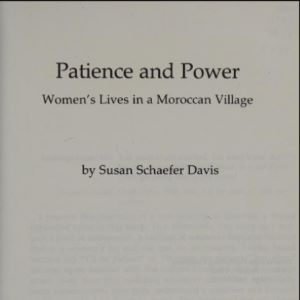Family Life

Nisa, The Life and Words of a !Kung Woman by Marjorie Shostak
Made up of a series of analyses and personal interviews conducted by Marjorie Shostak, Nisa, The Life and Words of a !Kung Woman is an anthropological work about women of the !Kung tribe of the Kalahari desert in southern Africa told through the perspective of one individual, N

Dreams of Trespass by Fatima Mernissi
Written by Moroccan feminist and sociologist Fatima Mernissi, Dreams of Trespass: Tales of a Harem Girlhood is a semi-fictional tale about a young girl growing up in a traditional Moroccan harem in the 1940s and 1950s.

Patience and Power by Susan Davis
Patience and Power, Women's Lives in a Moroccan Village is an anthology of anecdotes, interviews, and observations by American anthropologist Dr. Susan Schaefer Davis.

Calendar from Cham manuscript, early 20th century
An image of the Cham calendar from an early 20th century Cham manuscript. The column on the left and top row indicate measurements of months of the calendar drawn from the Islamic lunar calendar. Numerals written in Cham script in the middle are symbolic of the Cham Hindu solar calendar.
Ariya Cam Bini
Ariya Cam Bini is one of the few ariya that has little to no historical references in the poem. It is possible to deduce from the language of the poem and from the study of extant versions of the manuscript that its origins likely lie in the 19th century.
Short Teaching Module: Ariya Cam Bini, a 19th century Cham Poem
Ariya Cam Bini is a 19th–century epic poem written in the Austronesian Cham language of mainland Southeast Asia. The poem comes from the area called Pāṇḍuraṅga or Nâgar Cam, a pluralistic society in terms of culture, religion, and identity.

Long Teaching Module: Masculinity and Femininity in the Mongol Empire
This module examines ideals of masculinity and femininity among the Mongols, the Central Asian nomadic pastoralists who in the thirteenth century under their leader Chinggis Khan created the largest land-based empire the world has ever seen.

Sorghaghtani Beki in the eyes of court historians
Sorghaghtani Beki, the wife and then widow of Chinggis Khan’s youngest son Tolui, appears in many contemporary written sources about the Mongol Empire, and is always viewed positively.

Chinggis Khan and his wife Börte in The Secret History of the Mongols
Chinggis Khan had four sons by his principal wife Börte, though there is some question as to his eldest son Jochi’s true father.

Chinggis Khan’s mother Hogelun in The Secret History of the Mongols
The Secret History of the Mongols, the story of the rise and rule of Chinggis Khan and his son and successor Ogodei produced by an anonymous court scribe in about 1240, is full of close mother-son relationships.